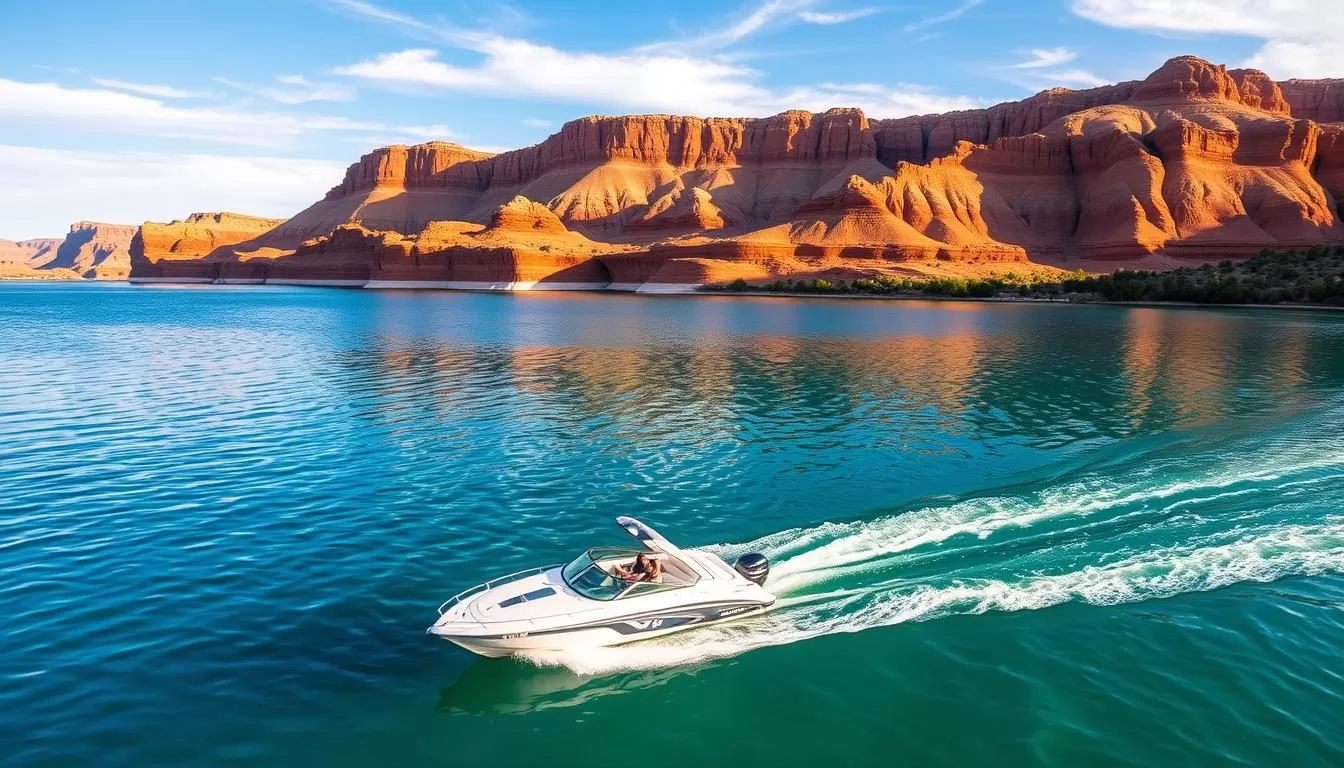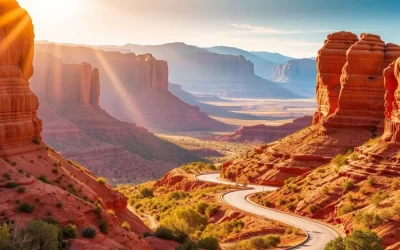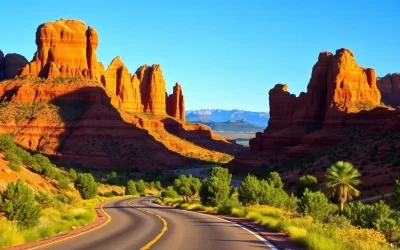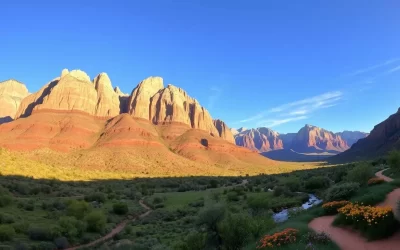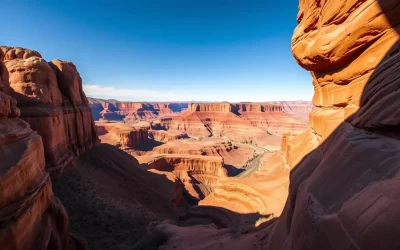Imagine a vast, man-made reservoir straddling the border between Utah and Arizona, offering visitors a unique blend of desert landscapes and water activities. Located within the Glen Canyon National Recreation Area, Lake Powell is a stunning destination that has become one of the most sought-after spots in the American Southwest.
This comprehensive guide will walk you through the best experiences at Lake Powell, from water adventures to cultural explorations. With its striking red rock formations contrasting against crystal blue waters, you’ll discover why this destination offers something for everyone, whether you’re planning a family vacation, a solo adventure, or a romantic getaway.
You’ll learn about the beauty of the area, the best times to visit, and essential preparations to make the most of your experience.
Discover the Wonders of Lake Powell
As you step into the majestic world of Lake Powell, you’ll uncover the secrets behind its creation and the wonders it holds. Located on the Utah-Arizona border, Lake Powell is a marvel of engineering and a testament to the natural beauty of the American Southwest.
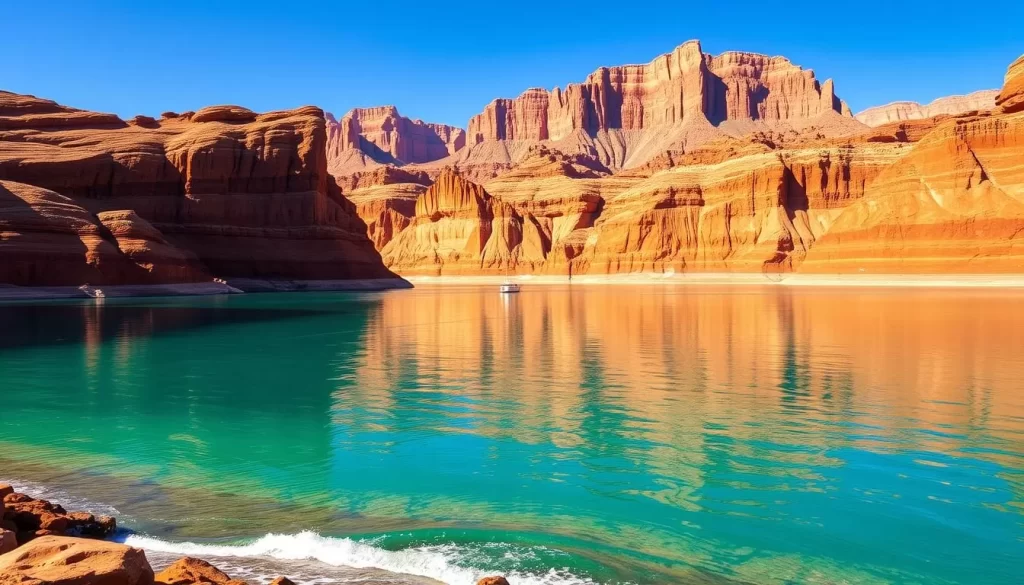
The History and Formation of Lake Powell
The story of Lake Powell began in 1963 when the Glen Canyon Dam was completed, transforming the Colorado River into a vast reservoir. The dam was constructed to address several needs related to water management and power generation in the region. Over years, the water level rose, creating the lake’s intricate shoreline and numerous coves and inlets.
Understanding the area’s geological history enhances your appreciation of the stunning landscapes. Millions of years of erosion carved the canyons that now form Lake Powell’s shoreline, making it a unique destination.
Best Time to Visit Lake Powell
The best time to visit Lake Powell depends on your preferred activities. Summer (years of visiting during this time have shown it to be ideal for water sports) offers ideal conditions, with temperatures often reaching 100°F. In contrast, spring and fall provide milder temperatures, perfect for hiking and exploring the area.
Visiting during the winter (years have shown that it can be a unique experience) offers a serene landscape with fewer crowds, though some services may be limited. The beauty of snow-dusted red rocks against the blue water creates a striking contrast. This, combined with the reflection on the importance of life and water in the desert, makes for a memorable visit.
Water Adventures at Lake Powell
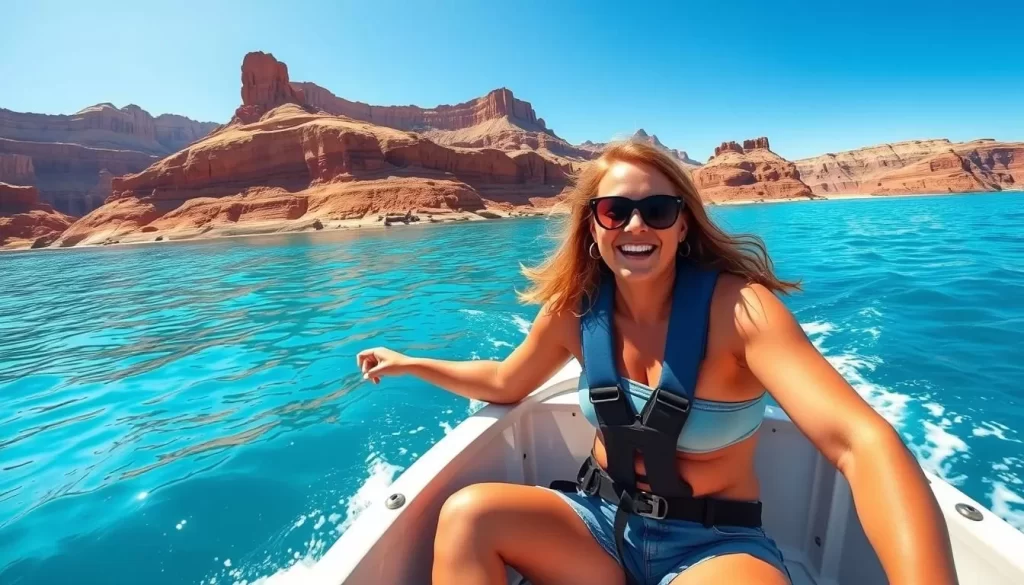
Experience the ultimate water adventure at Lake Powell, where the possibilities are endless and the fun is guaranteed. Whether you’re looking for relaxation or adrenaline-pumping activities, Lake Powell has something for everyone.
Boating and Houseboating
Boating is the quintessential Lake Powell experience. You can rent a powerboat for a day of exploration or embark on a multi-day houseboat adventure, waking up to stunning canyon views each morning. Houseboating offers the ultimate Lake Powell experience, serving as both your transportation and accommodation. Vessels range from basic models to luxury options featuring hot tubs, slides, and multiple decks.
Kayaking and Paddleboarding
For a more intimate water experience, you can rent kayaks or paddleboards to navigate the narrow slot canyons and hidden coves that larger boats can’t access. This provides a peaceful way to connect with the landscape and enjoy the serene beauty of Lake Powell.
Fishing Opportunities Year-Round
Fishing enthusiasts will appreciate Lake Powell’s year-round opportunities. The lake is abundant with striped bass, smallmouth bass, walleye, and crappie. Winter fishing is particularly rewarding as fish rise to cooler surface waters. You can rent boats from multiple locations, including Wahweap Marina and Antelope Point Marina, with options to suit every budget and experience level.
Lake Powell remains accessible for boating activities even in winter conditions, as the water doesn’t freeze except at its northernmost point. This offers a unique off-season adventure with fewer crowds and spectacular stargazing opportunities from a houseboat’s top deck.
Must-See Natural Wonders Around Lake Powell
Beyond the shores of Lake Powell lie three must-see natural wonders that are steeped in history and natural beauty. These attractions offer a mix of hiking, boating, and breathtaking views that showcase the incredible geological diversity of the area.
Horseshoe Bend Viewpoint
You’ll be awestruck by Horseshoe Bend, where the Colorado River makes a dramatic 270-degree turn, creating one of the most photographed landscapes in the Southwest. Accessible via a 1.5-mile round-trip hike from the parking area, this natural wonder is a must-visit.
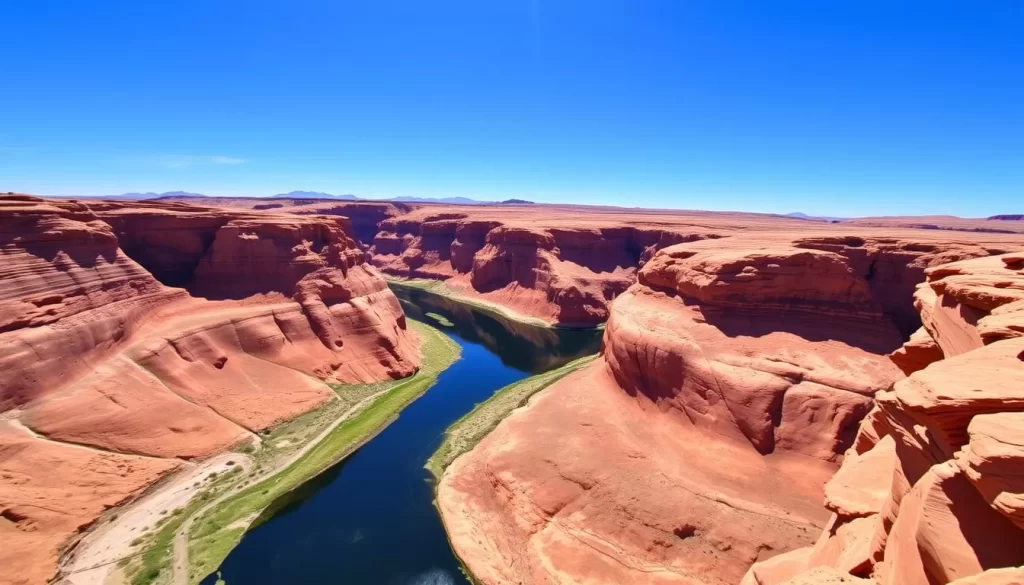
Rainbow Bridge National Monument
Rainbow Bridge National Monument stands as one of the world’s largest natural bridges at an impressive 290 feet tall. It holds deep spiritual significance for the Navajo people as a symbol of deities responsible for creating rain. You can access Rainbow Bridge either by taking a boat tour from Lake Powell or by embarking on a strenuous 14-mile round-trip hike from Navajo Mountain with proper permits.
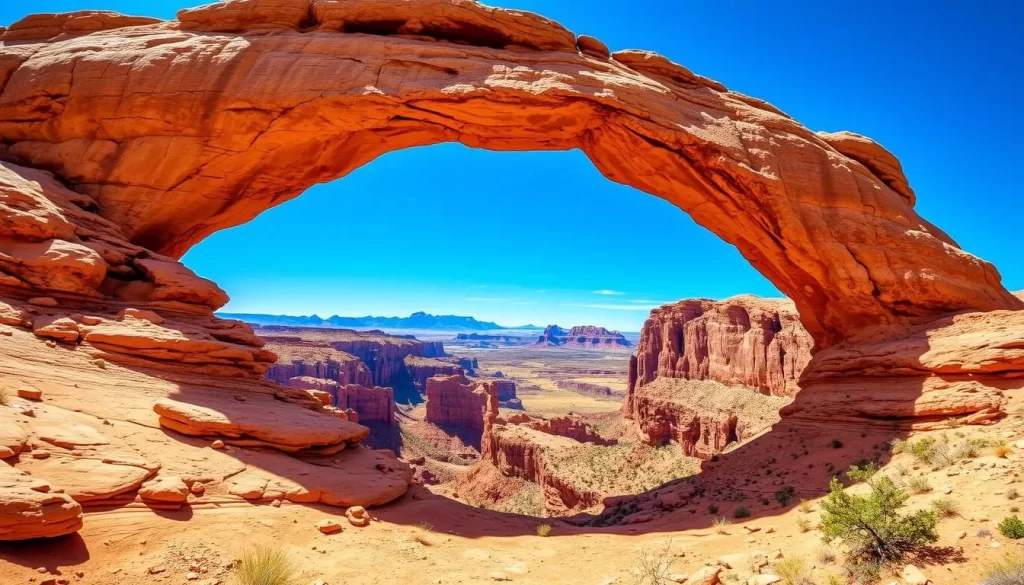
Hanging Gardens Trail
The Hanging Gardens Trail offers a surprising oasis in the desert landscape, where water seeping through sandstone creates lush, hanging gardens of plants that remain green year-round. This unique phenomenon provides a stark and beautiful contrast to the surrounding red rock environment.
These natural wonders around Lake Powell, including Horseshoe Bend, Rainbow Bridge National Monument, and the Hanging Gardens Trail, showcase the incredible geological diversity of the area. From massive stone arches to winding river views and unexpected pockets of greenery, all are accessible through various hiking trails and boat excursions.
Exploring Antelope Canyon
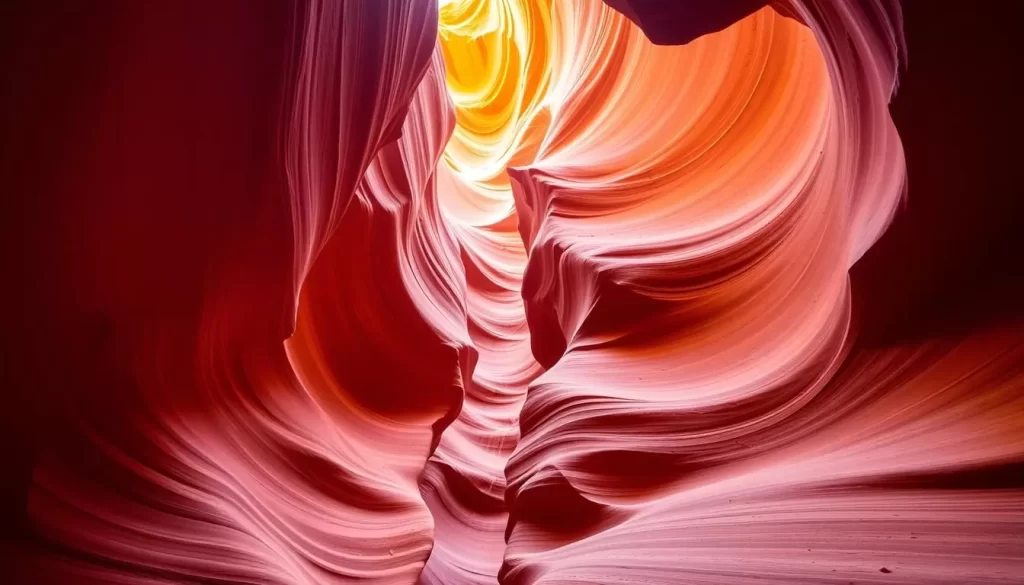
The majestic Antelope Canyon, with its surreal sandstone formations, is an experience unlike any other. As one of the most photographed slot canyons in the world, it attracts visitors and photographers alike.
You’ll be mesmerized by Antelope Canyon, where sunbeams dance through narrow openings to create an otherworldly light show on the smooth, flowing sandstone walls. The experience is truly breathtaking.
Upper vs. Lower Antelope Canyon
Upper Antelope Canyon, also known as “The Crack,” is more accessible and famous for its light beams that pierce through the canyon during midday. In contrast, Lower Antelope Canyon, or “The Corkscrew,” requires navigating stairs and ladders but rewards you with fewer crowds and equally stunning formations.
Kayaking to Antelope Canyon
For a more independent adventure, you can access Antelope Canyon by kayaking from Antelope Point Marina. Paddling approximately 2 miles, you’ll reach the canyon entrance where you can beach your kayak and explore on foot. This route offers a unique perspective that most tourists don’t experience.
All land-based visits to Antelope Canyon require booking a guided tour with Navajo-authorized tour companies. For photography enthusiasts, consider specialized photography tours that provide extended time in the slot canyons and insights on capturing the best shots.
Lake Powell, Utah: Best Things to Do Beyond the Water
While Lake Powell is known for its water activities, the surrounding area is ripe for exploration. The Glen Canyon National Recreation Area offers a diverse range of landscapes and activities that complement the water adventures.
Glen Canyon Dam and Visitor Center
To get an understanding of the engineering marvel that created Lake Powell, visit the Glen Canyon Dam and the Carl Hayden Visitor Center. The center features interactive displays that focus on water conservation and the dam’s impact on the environment. A short walk takes you onto the bridge over the dam, offering stunning views of the lake and the river.
Beehives Trail (The New Wave)
Located just a half-mile from the visitor center, the Beehives Trail, also known as “The New Wave,” is a 1.9-mile loop hike that showcases unique sandstone formations. Unlike the more famous Wave at Coyote Buttes, this trail does not require a permit, making it an accessible alternative for photographers and families.
Mountain Biking on the Rim Trail
For those who enjoy mountain biking, the Rim Trail is a 10.8-mile route that circles the city of Page. The trail offers 75% singletrack with a manageable max grade, making it suitable for both novice and experienced riders. The views of Lake Powell and the surrounding Glen Canyon National Recreation Area are spectacular.
| Activity | Location | Description |
|---|---|---|
| Visit Glen Canyon Dam | Glen Canyon Dam and Visitor Center | Learn about the dam’s engineering and conservation efforts |
| Hike Beehives Trail | Near Carl Hayden Visitor Center | Explore unique sandstone formations on a 1.9-mile loop |
| Mountain Biking | Rim Trail, Page | Ride a 10.8-mile trail with singletrack and views of Lake Powell |
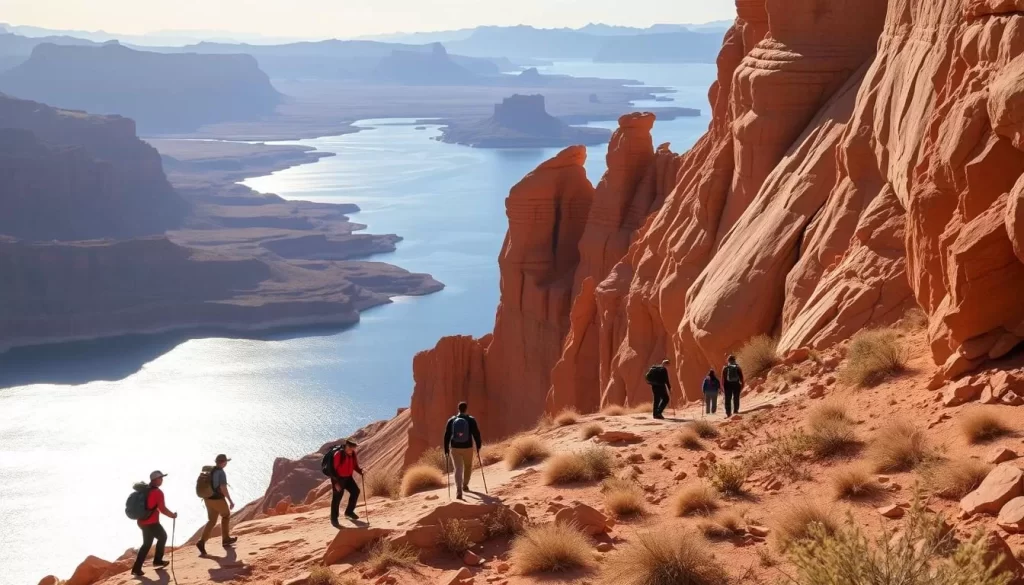
Cultural Experiences and Indigenous Lands
Lake Powell is not just a natural wonder; it’s also a region steeped in cultural history and home to various indigenous tribes. The area around Lake Powell is significant to several Native American groups, including the Navajo Nation, whose ancestral lands encompass much of the region.
Navajo Nation Sites
The Navajo Nation plays a vital role in the area’s cultural landscape, owning and operating Antelope Point Marina, and governing the land around famous attractions like Antelope Canyon. Visitors can experience these natural wonders while supporting indigenous communities. Sites like Rainbow Bridge are considered sacred by the Navajo people, adding a layer of cultural depth to your visit.
| Attraction | Managed By | Cultural Significance |
|---|---|---|
| Antelope Canyon | Navajo Nation | Iconic slot canyon with stunning rock formations |
| Rainbow Bridge | Navajo Nation | Sacred natural bridge, significant to Navajo heritage |
Powell Museum
For a deeper understanding of the region’s history and the explorer it’s named after, visit the John Wesley Powell Museum in Page, Arizona. The museum showcases Powell‘s expeditions and the natural and cultural history of the area, including the geology of the Colorado Plateau and the traditional cultures of Native American tribes.
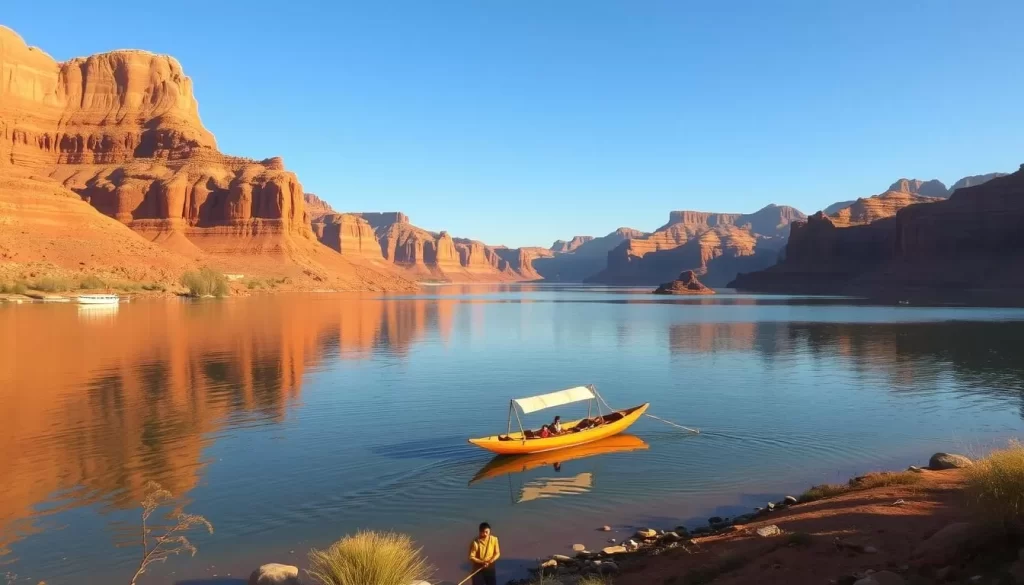
By engaging with these cultural experiences, you’ll gain a richer understanding of how the beauty of Lake Powell has shaped human life and spirituality in this region for centuries. Visitors can respectfully explore various sites within the Navajo Nation, learning about traditions that have sustained these communities for generations.
Practical Information for Your Lake Powell Visit
Before you embark on your Lake Powell adventure, there are several practical considerations to keep in mind. Glen Canyon National Recreation Area, where Lake Powell is located, offers a wide range of activities and experiences.
To access Lake Powell, you’ll need to purchase a Glen Canyon National Recreation Area pass. Options range from a 7-day vehicle pass ($30) to an annual America the Beautiful Pass ($80) that covers all national parks and federal recreation lands.
The two main access points to Lake Powell are Wahweap Marina near Page, Arizona, and Bullfrog Marina in Utah. Each offers different amenities and proximity to various attractions. It’s essential to plan your trip carefully, considering that Lake Powell spans 1.2 million acres with limited services.
- Plan your day trips and extended adventures on the lake by bringing plenty of water, sun protection, and supplies.
- Accommodation options range from camping along the shoreline to houseboats, hotels in Page, and vacation rentals.
- Check the National Park Service website for the latest updates on marina access, boat ramp availability, and tour operations before your visit.
- A typical Lake Powell itinerary might include a mix of water activities and land exploration.
- Consider the seasonal timing of your visit, as conditions vary significantly throughout the year.
For an enhanced experience, consider guided tours, such as boat tours to Rainbow Bridge or Navajo-led excursions through Antelope Canyon. These provide expert knowledge and access to areas that might be challenging to reach independently.
